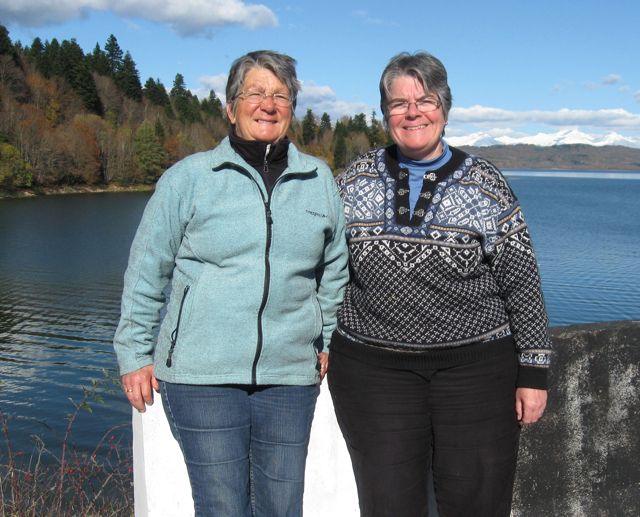
19 October - 29 October

Last update 29th October
I welcome feedback on this blog. Please write to Stephanie
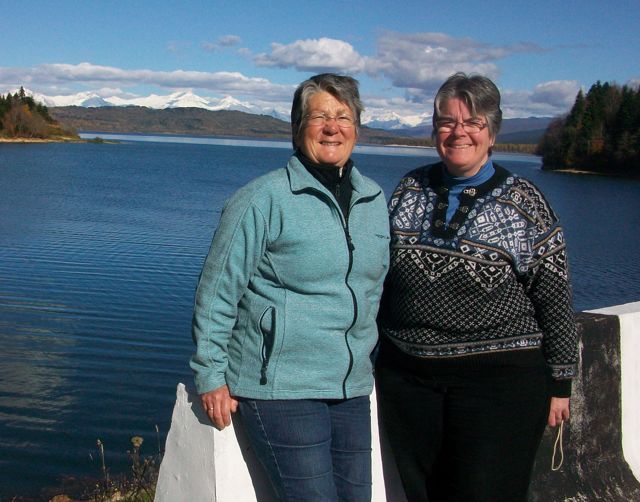
Beth and Stephanie in Racha October 2011
Wednesday 19th October
Anxious not to miss the alarm, John and I were up and running at 3:30am - Maylee chose to stay in bed! We did all make it to the airport an hour before the 6:10 am flight to Amsterdam for a transfer to Georgian Airways to Tbilisi. Immediately in travel mode, and loved flying up through billowing clouds. The journey went quickly, but no views of the Caucasus as it was cloudy. Beth was at the airport to greet me, but my luggage was not - hopefully it will arrive before we leave for the mountains!
Lovely welcome from Beth and her driver Temori, and within half an hour we were back in familiar Tbilisi, traffic chaotic, pavements still uneven, and Beth's entrance way as unsalubrious as ever. Briefly settled in (nothing to unpack), and we went out to a local Thai restaurant round the corner for supper and catch up. The world of mobile phones has hit Beth without her realising, she constantly receives texts and messages as well as calls, so it is hard to just 'switch off'. So, what did I do when we returned to her flat, but set up my computer to be in touch with my world that way!!
In borrowed flannelette nightie, I was relieved to be horizontal on the sofa rather early. Georgia is currently three hours ahead of British summer time.
Thursday 20th October
The first full day here, so full of new experiences. The weather is very autumnal with strong winds, so the snows have come early and we will not now be able to travel to the Tusheti region we had planned to visit. With a little guidance from Beth, I am researching the possibility of Kazbegi and Shatili in the north of the map below for the weekend, then next week we hope to make a visit further to the north west in the Racha province.
This morning I walked all the way downtown again (didn't seem quite as far as last year!) I passed the universities - students in their winter leather jackets and tight jeans, all ages wearing dark clothes. The wind was blowing the leaves off the tree-lined streets. Since I was last here the National Museum has re-opened, so I was able to visit the exhibitions. There are currently three floors only, one on Archaeological excavations, mostly of goldsmithing from the 8th century to the 1st century BC - some absolutely exquisite pieces, I just find it hard to get my head around the craftmanship so long ago. The next was a temporary exhibition on agricultural instruments from ancient times, including those used for making wine - the method is still being used today. The third was a very dark and depressing exhibition of the Soviet Occupation from 1921 to 1991. All in all I thought it was a good beginning in the restoration process of the museum - all the exhibits were labelled in Georgian and in English.
I popped in to a few agents enquiring about travel to Kazbegi and Shatili, and received different information from each concerning the weather and whether or not they would be accessible - I will follow up with Beth this evening - she will be home from work around 6pm. I telephoned about the baggage - located in Amsterdam, it may arrive tomorrow morning at 5am - I am to telephone after 9am!
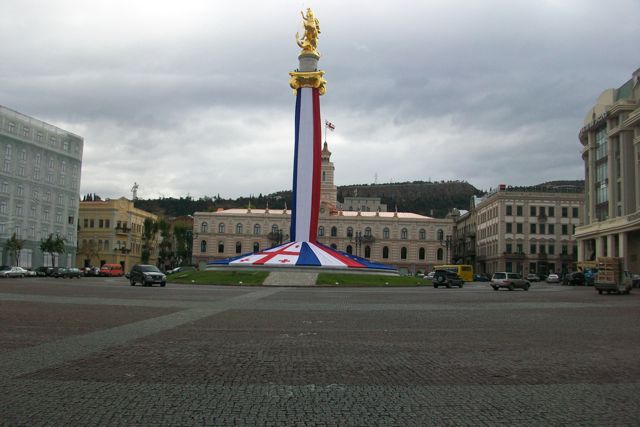
President Nicholas Sarkozy visited last week, so the statue of St George spearing his dragon in Tavisuplebus square has been draped in the French flag
In the afternoon I went out exploring to the East and ended up in Vake Park, on the edge of the city, where there is a giant black statue of Lady Victory. Last year I climbed up here to Turtle Lake, but this time I turned on to Chavchavadze Avenue and found my way back to the flat. Beth was home by 6 pm and we had a good evening catching up on her school with the ups and downs, but both concluding that it is the right place for her to be in the foreseeable future. Her experience and efforts are all so appreciated here.
Friday 21st October
The bag arrived, and Temori, Beth's driver took me all the way out to the airport to pick it up. The security was nonchalant to say the least, and we both went into the arrivals hall to pick it up. Back at the flat by midday, thinking why do I need all this stuff anyway, but it comprised mainly my thermal clothes ready for the mountains. Today was bright and sunny, and the snow capped Caucasus were visible to the north and east. I decided to go exploring in the afternoon, and took the number 61 bus all the way downtown, then walked on into the old area of the city where the baths are. I was determined to try a hike I had read about in Peter Nasmyth's book Walking in the Caucasus, and indeed found my way out of the city and into the hills very quickly - how many cities can you walk out of into the hills?

The new pedestrian bridge is now complete, and behind the view of the new Presidents Palace - both very controversial!
I commenced my hike from close to here and walked up Grishashvili Street heading up cobbles into the old Jewish area. The houses were all on top of one another, and very old. The road dead ended, but there were steps upwards to more houses, and then through the last one I was on the hillside and heading up to the new Transfiguration Church which overlooks the old town.
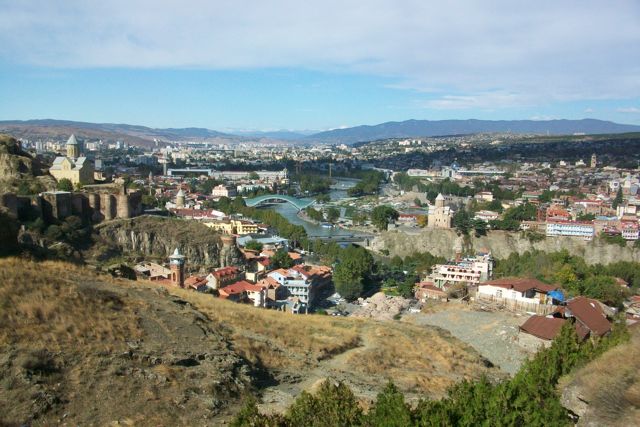
The views of Old Tbilisi, the Narikala Fortess on the left and snow capped mountains to the east
The trail up through the woods began here, and I headed up for about an hour into the hills. I tried to find a way down according to the instructions, and followed one or two false trails landing on the edge of a deep ravine, but given the instructions said the path was faint and difficult to find, I decided to return the way I had come, having really enjoyed an afternoon in the countryside. The cobbles were far more difficult to go down than up!
Back in the old city, I walked with the crowds up to Tavisupleba Square and caught a 61 bus back for 5 pm, stopping to buy croissants for our breakfast on the way. When Beth came home, we talked about the plans for the weekend, then went out to eat with New Zealand friends who work in Baku, Azerbaijan. The restaurant was called the windmill, way out of town on the river, and quite a museum in itself. There were lots of levels and rooms, traditional music and dancers, and great food. It was packed with local Georgian groups enjoying their food, drink and entertainment.
Saturday 23rd October
North from Tbilisi you will see Kazbegi which is where we currently are just a few kilometers from the Russian border, it is on the Georgian Military Highway! Our journey brought us through a high mountain pass of 2395 meters into the snowy Caucasus.

Last night around 10pm, Beth managed to fix a recommended driver with a 4 by 4 for today's trip into the high mountains - Georgia and Beth live on 'last minute.com', so are good matches! 10am precisely we walked out of the apartment block and Dato was waiting with his Honda CR5 - how brilliant was that. Dato is a great driver and guide with a huge sense of humour and good enough English for us to appreciate it. Better still he is a very good driver!
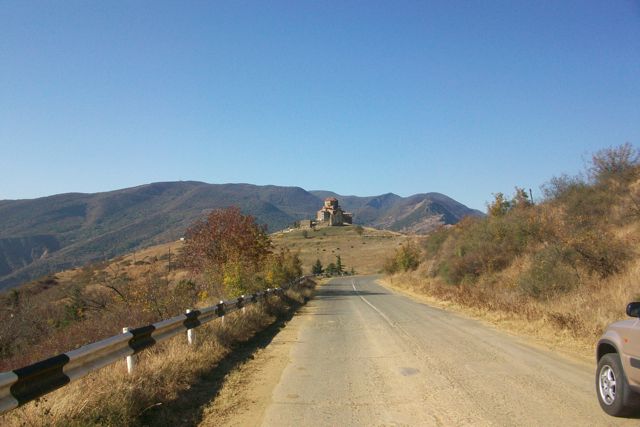
We headed first to Jvari Church, which to many Georgians is very holy - hence even at that time of day it was quite crowded. It stands where a sacred cross was erected by St Nino in the 4th century. It is being renovated, but we were able to go inside -lots of candles, a large wooden cross and lots of scarved women and children lighting candles and crossing themselves. I loved the stonework and atmosphere. Interesting that we looked down on Mtshketa - the ancient royal and religious capital of Georgia at the confluence of two rivers - the Mtkavari and Aragi.
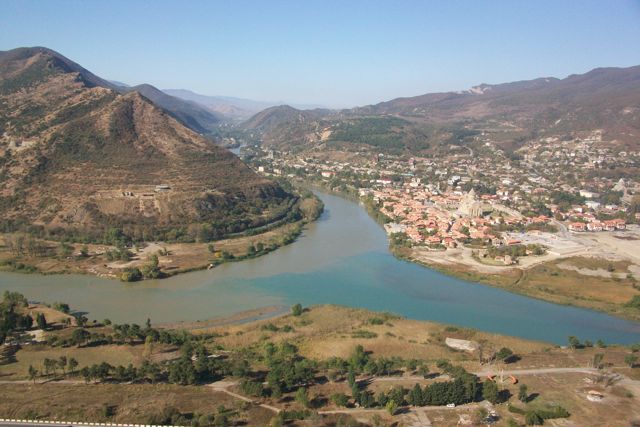
We also discovered from Dato that this was where the Russians had a huge military presence until 1991, including an underground base and an atomic research station - the latter was dismantled after the Republic was formed but the former only discovered four years ago!
Heading up now towards the high mountains, the scenery became more spectacular especially when the turquoise Zhinvali reservoir came into view, with the stategically placed Ananuri Fortress and church at the end.
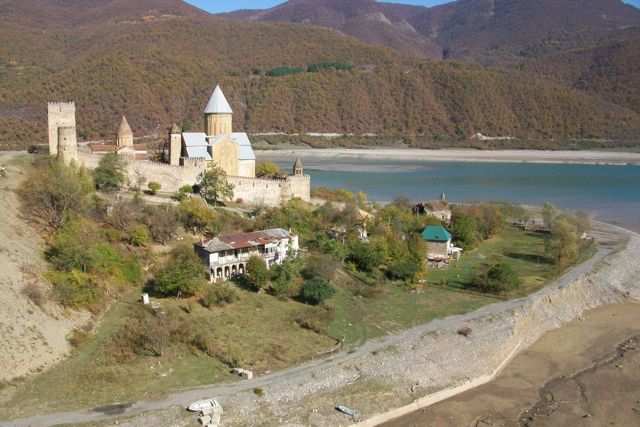
We then headed higher,and the road began to deteriorate as we headed up hair pin bends. There are always places to stop and view, and although this used to be a major crossing point into Russia, not there are now just a few lorries, and most people cannot cross at the border, so the road is almost empty.

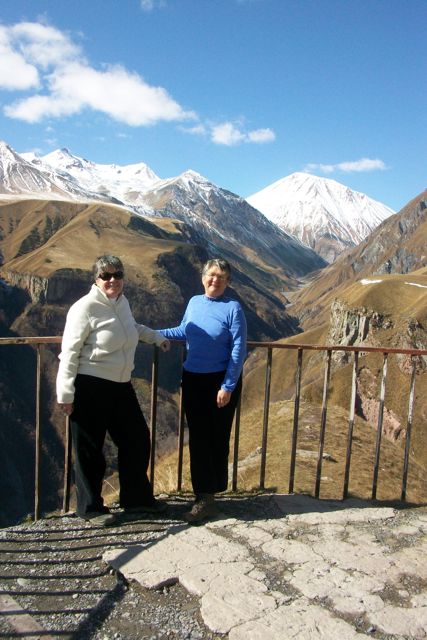
At the viewpoints in the middle of nowhere there are always ladies knitting and selling their wares.
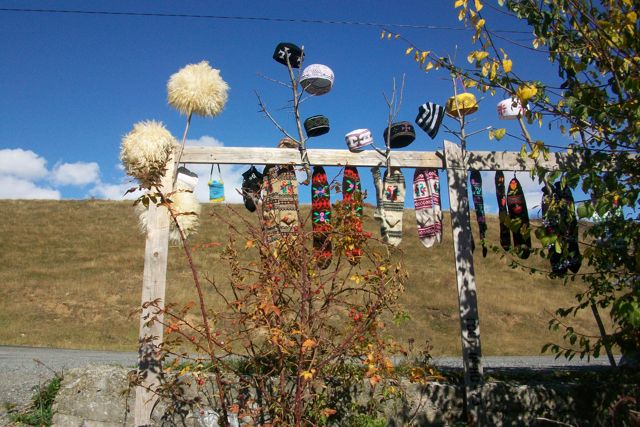
On to a monument for friendship between Georgia and Russia, which has surprisingly not yet been demolished

We passed through the small ski resort of Gudauri just below the Jvari pass 2379 m, which takes its name from a cross erected here by King David the Builder. There are many avalanches in this area, so there were snow tunnels, not currently being used, but over the pass we soon hit the snow.

Within 10kms down the far side we had reached our destination of Kazbegi, now officially called Stepantsminda (Saint Stephen). It is a very sleepy mountain village at 1750m, dominated by the snow capped mountains, especially the peak of Mount Kazbek (3902m) and the stunningly located Sameba church to the left of this.
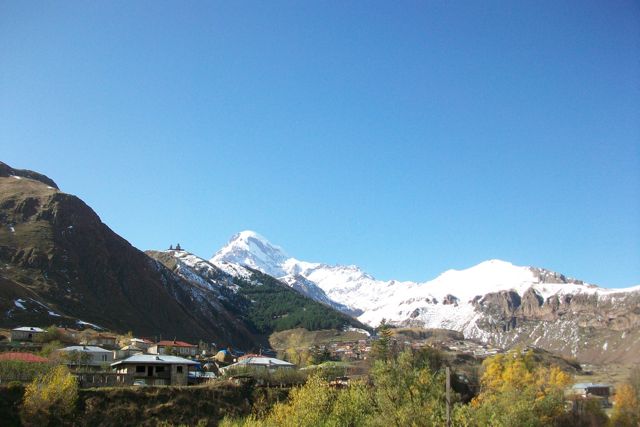
Dato dropped us and our bags in the centre of the village where our small Shorerna's guest house was located. We had a coffee on the balcony and ate Khachapuri in the fresh mountain air.


In the afternoon we just wandered round the village, looking at what life is like in such wonderful surroundings.

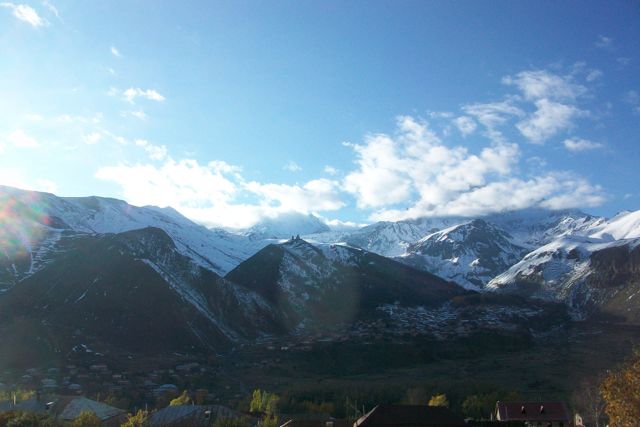
In the evening we caught up with the blog and enjoyed a simple meal of Kebabs and aubergine salad.

Before retiring we wandered out to look at the stars - a wonderful display.
Sunday 23rd October
Breakfast in Kazbegi

We set off for the mountains and Sameba Trinity Church on the mountain top. This was an amazing day - about six hours hiking to get up to the church.
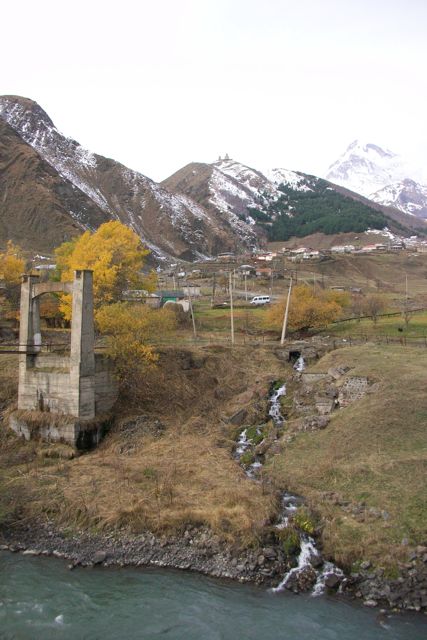
We first hiked up through the village of Gergeti looking at village life, including bee hives in old houses.
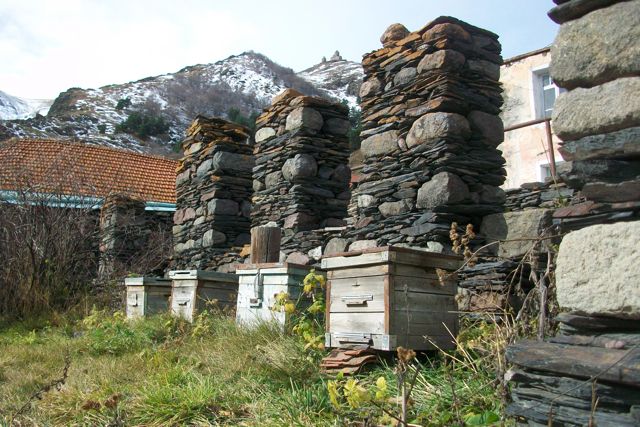
Typical house in the village.
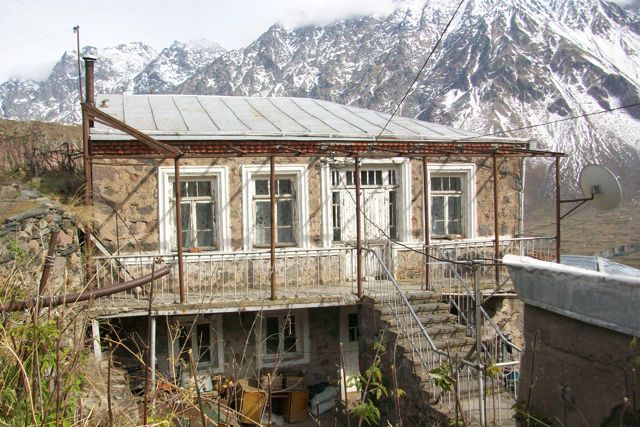
We hiked up past the cemetery above the village - just gorgeous landscape - a struggle sometimes in the snow.
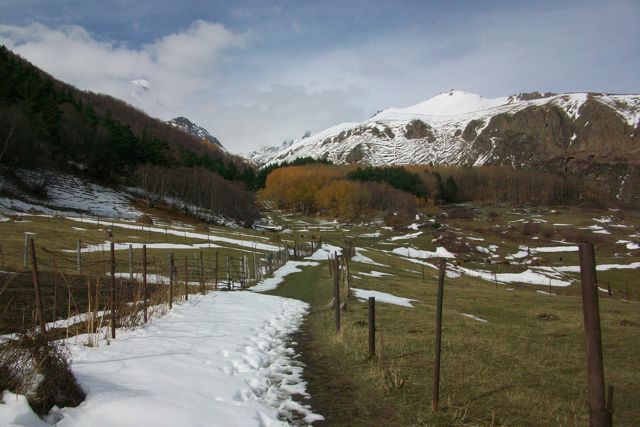
We met a Polish lady who took our photograph when we had climbed through an amazing valley in the snow.

We took a short cut through a forest, and emerged near this cross with a view of our destination.
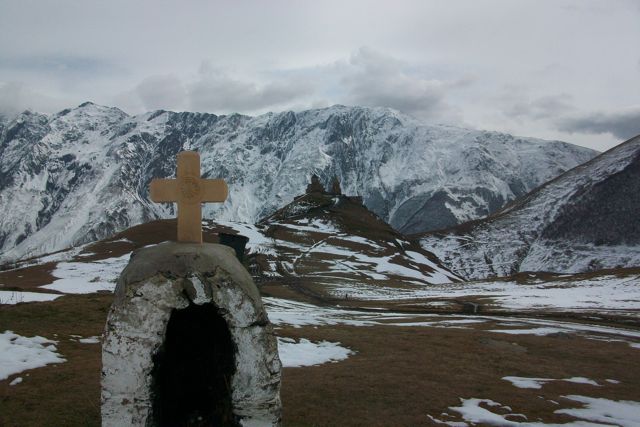
Absolutely stunning mountain vistas all around.
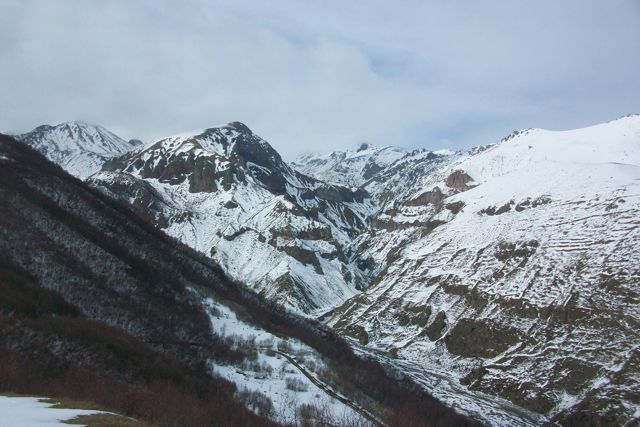
We met Sarah, a music therapist from Edinburgh who took a photograph of us with Sameba Church in the background.

View back down to Kazbegi from Sameba.
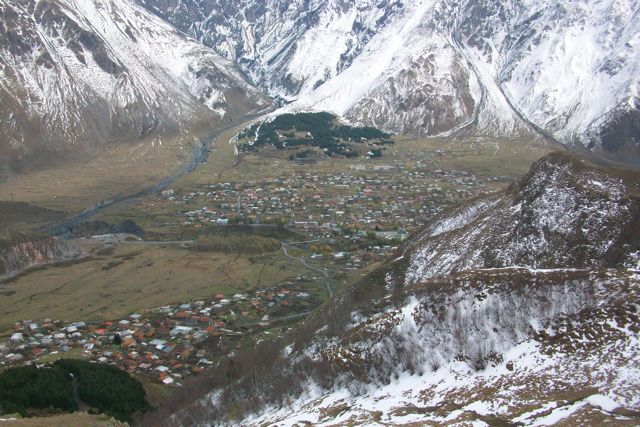
What a wonderful opportunity to be out in the remote Caucasus.

This was our wonderful companion on the way back down.
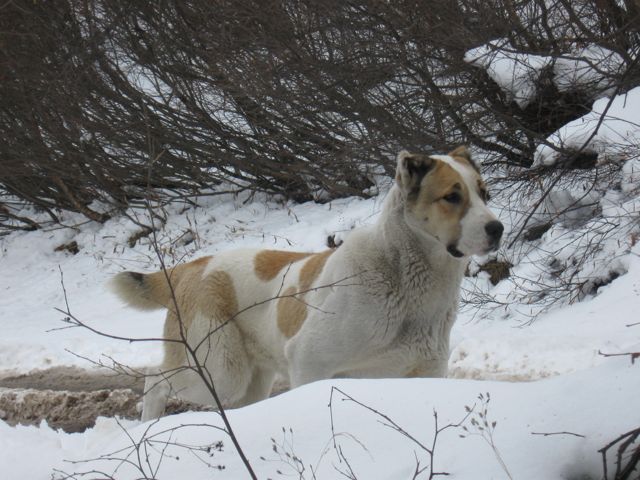
Boy were we happy to arrive back at our guest house around 5 pm? Our room was the one on the left with the overhang.
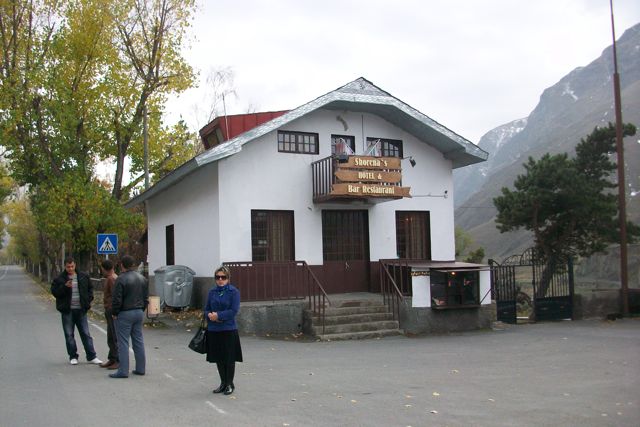
The power went out , so by candlelight, we had dinner of dolmas and salad.

Monday 24th October
Just to think we walked up to the 14th century church yesterday with Mount Kazbek in the background! Great breakfast shot with Beth's telephoto.

We had a much gentler morning walking around Kazbegi town. Cows just wander at will during the day time as well.

The mountain air and light really brings out the colour of the stone. There are many silver birch trees, which were shedding their leaves, but gave an autumnal glow.

Everywhere is quiet and peaceful, most people are involved in farming, with guest houses on the side for the hiking season which is coming to a close as winter draws in.
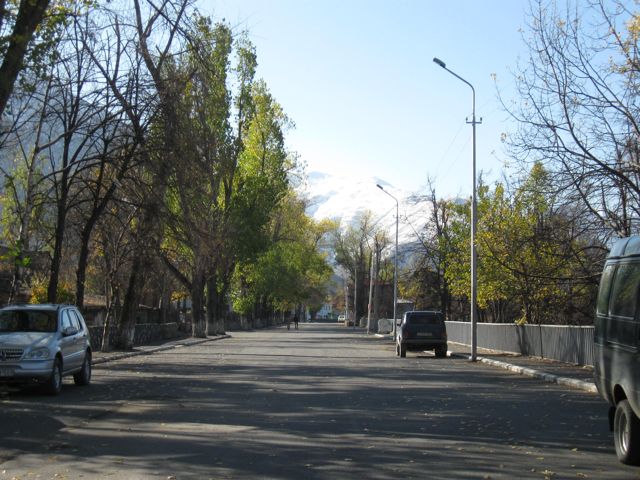
This view was into Russia, and the cloud was creeping up the valley. We saw raptors heading west - this is a migratory passage for them. They had huge wingspans and were light underneath, we watched them on the thermals. They could have been Lammergeiers which are prevalent, or the Eurasion Griffin Vulture - we shall never know!!
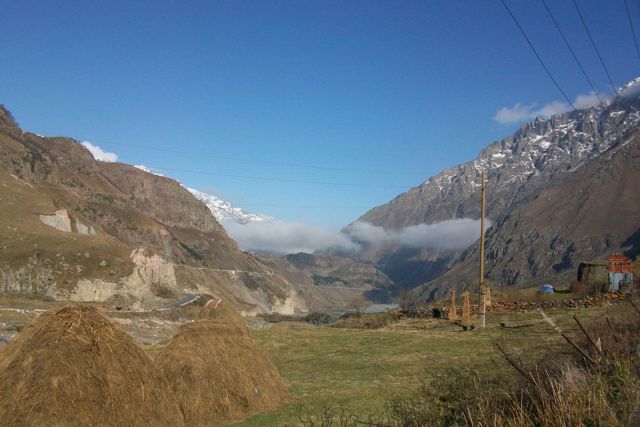
A last glimpse of Sameba and Mount Kazbek before our driver Dato picked us up around 1:30pm to take us back to Tbilisi.
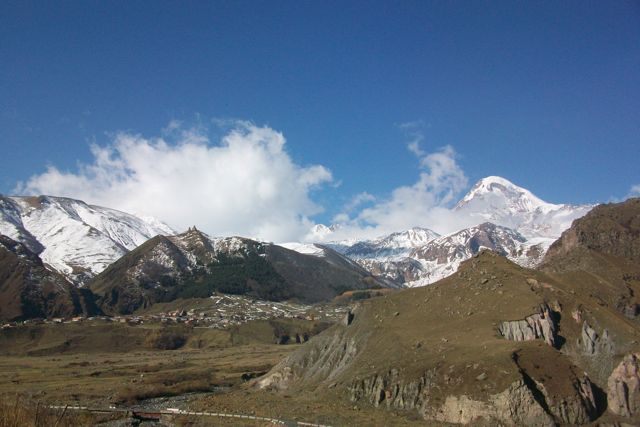
The weather was quite cloudy and it was snowing as we went over the pass, but we got a good look at the Georgia-Russia friendship monument from above - we speculated that they may once again become friendly in the future!
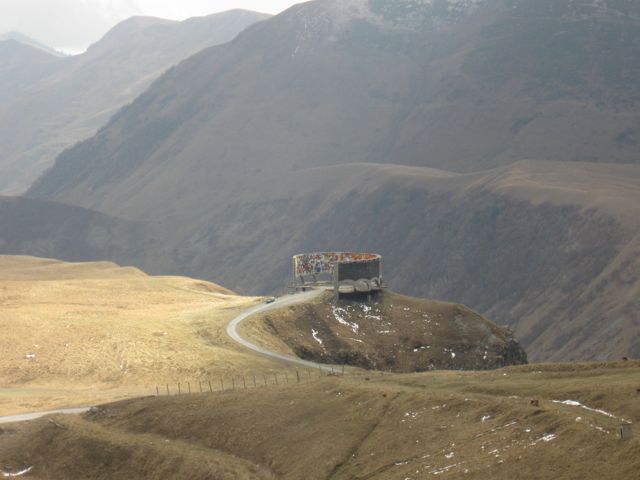
We encountered several herds of sheep and goats being herded down the road from the high mountain pastures for the winters - it was fascinating to see the cars negotiating these - Dato was an expert at getting through.

Donkeys as well as horses are used extensively for transport.
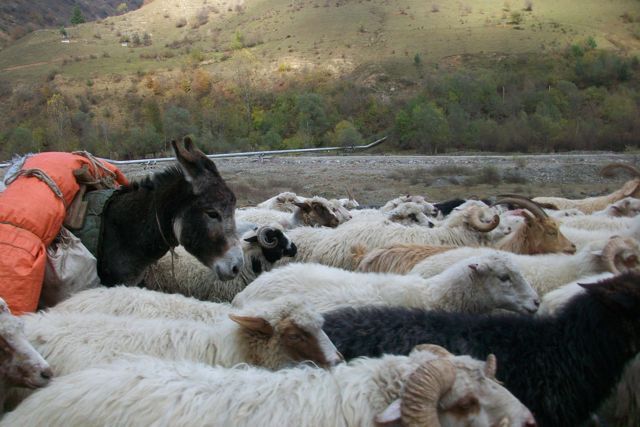
The large Caucasian dogs are used to protect the sheep as they are larger and stronger than the wolf which is still prevalent and widespread up to 3500m. (They take sheep, but we were assured that they are shy of humans, and rarely attack!)

We returned to the busy city by around 5pm to re-group and sort out for our trip to Racha tomorrow.
Tuesday 25th October
Today we set off for the province of Racha in the North West for four days. This is next to South Ossetia, an independent, break-away region of Georgia, recognized by very few countries. We headed for Ambrolauri today.
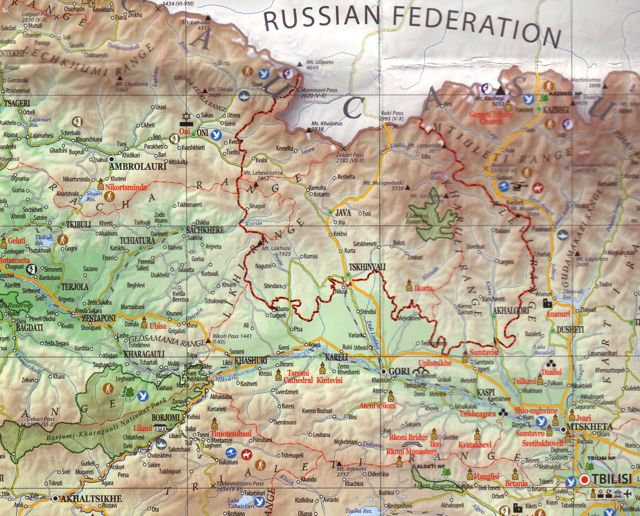
We were picked up at 8:30 by Marika, our driver Khaka and Ceil, an American friend of Beth who used to live in Tblisi. The route was the same as we took last year on our trip to Svaneti, first heading out the freeway heading from East to West Georgia.

We again passed large IDP settlements for displaced people from Abkhazia and South Ossetia.

The nazuki bread was still being made in the tone ovens and sold on the pass between East and West Georgia.
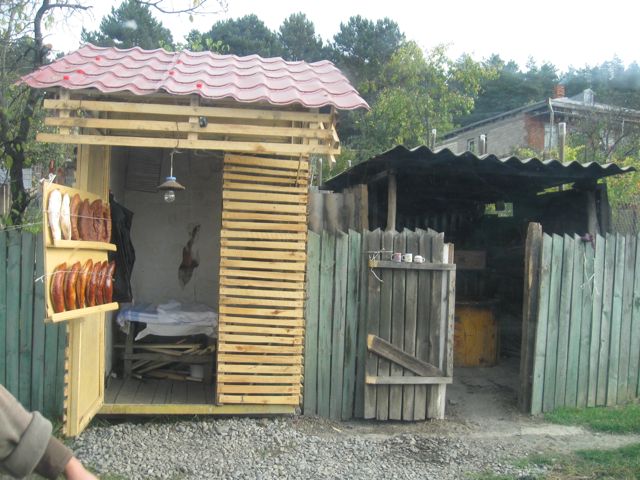
Once over the pass and into West Georgia we stopped for Turkish coffee at an old wooden house.
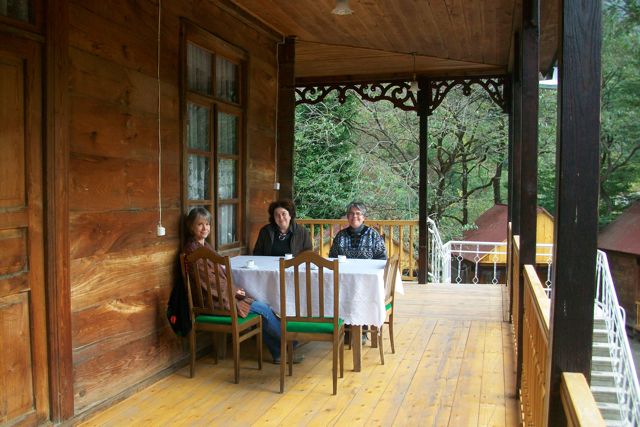
We turned off the main route and headed north into the hills, stopping before we went to Racha at an old mining town, Tkibuli, for lunch - the lower part of the town was quite depressed as the mine closed down. We found a place to eat in the centre of town, and the Imeretian Khachapuri was particularly good as this is the area it comes from.
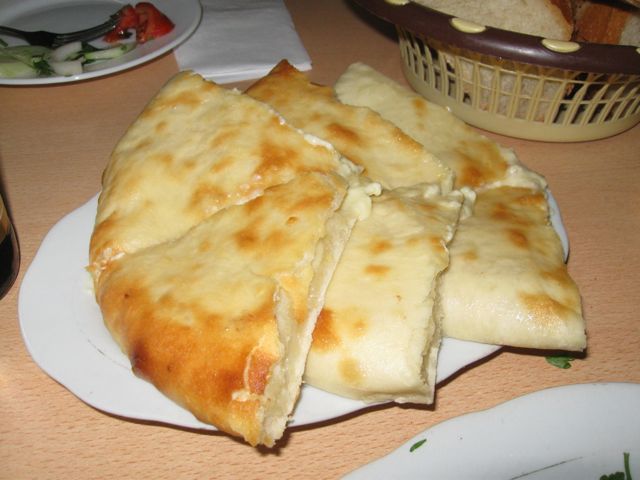
We then climbed up into the Racha range of mountains, and came over a pass, and suddenly we had ascended into Autumn.
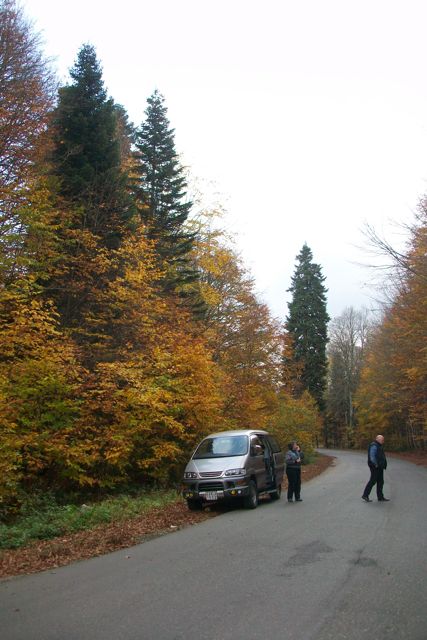

We stopped for a short walk by the high level Shaori reservoir.

The hips, haws and berries were stunning - I thought these were a viburnum, but are apparently sold and eaten in the market at this time of the year - they tasted bitter to me.
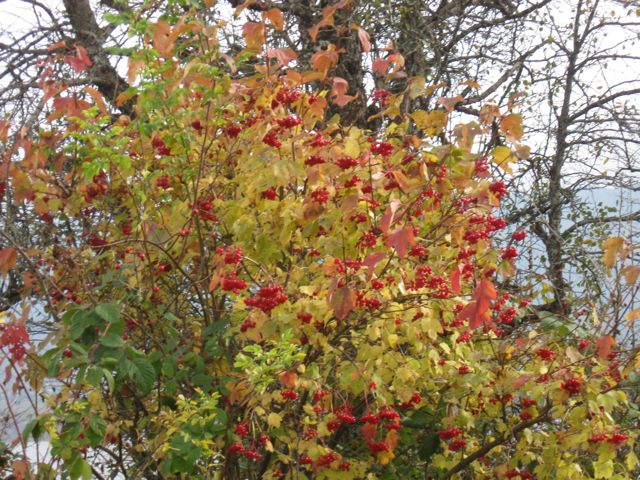
Our next stop was at an 11th century famous church called to Nikortsminda. It is especially famous for the facade decorations. It is a church for Saint Nicholas, and is in the shape of a cross. Inside it was covered in 16th century frescoes - really impressive. This area had a bad earthquake in 1991, but the damage here has now been repaired.
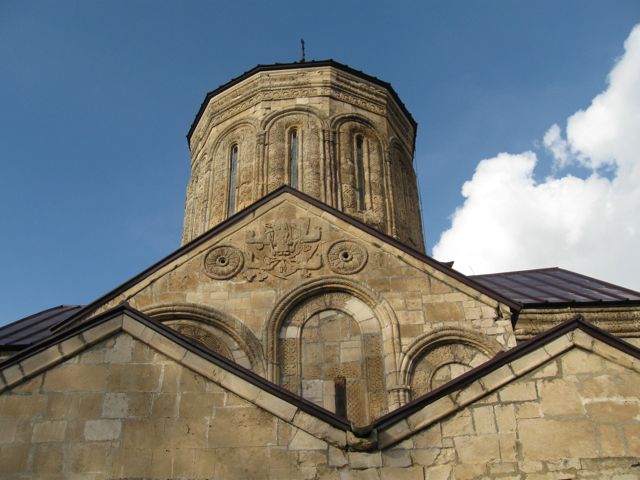
I love the doors.
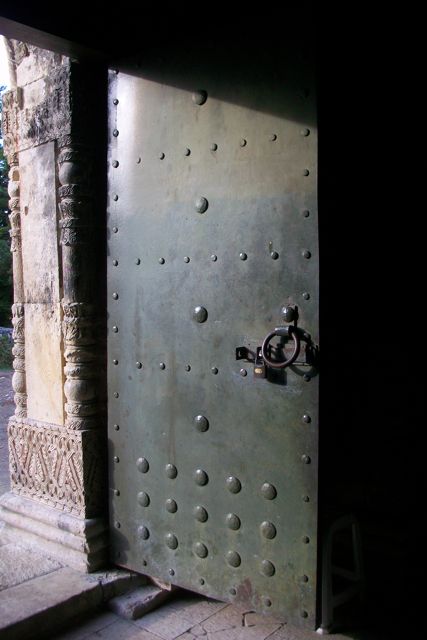
We were now entering grape and subsequently wine country.

We drove through fields of vine to the capital of Lower Racha, Ambrolauri on the river Rioni - the cows were making their way home over the bridge.
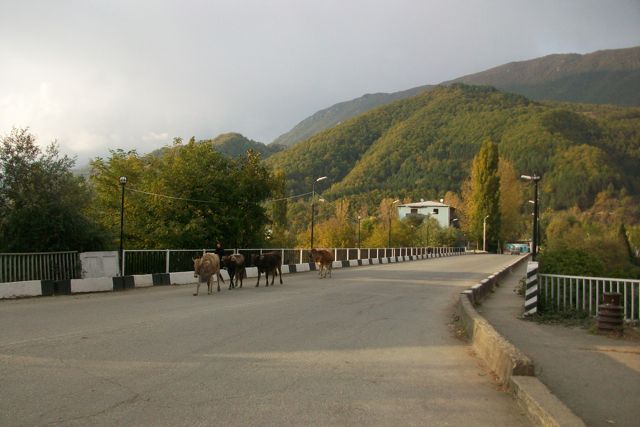
The centre of the town advertises the local wine.
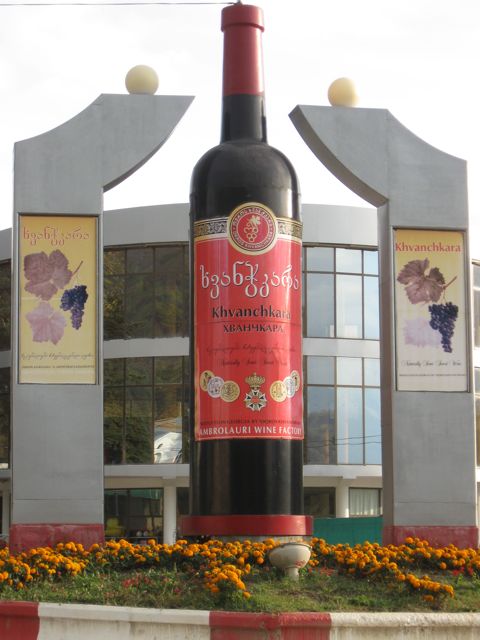
Our host father, Merab met us and took us to the local winery where this was made. It was a very low key event, and we were taken into the refridgerated area where the wine is kept for a year at -4 degrees. These were the workers, who siphoned off a couple of glasses for us to share.
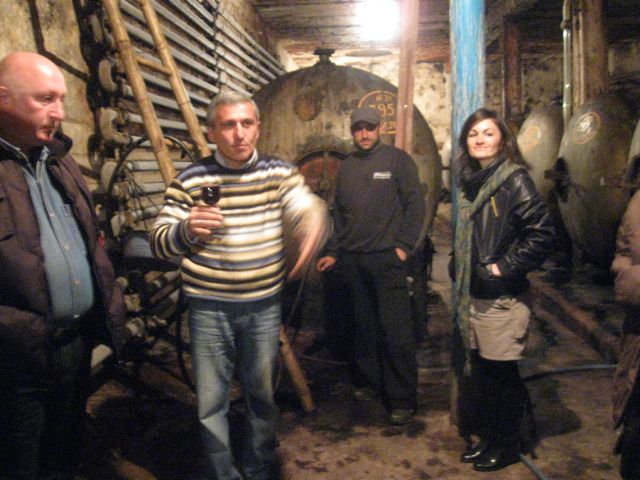
Having recently visited a cooperage in Scotland, I was amazed to see these huge casks where the wine is made and matured for three weeks.
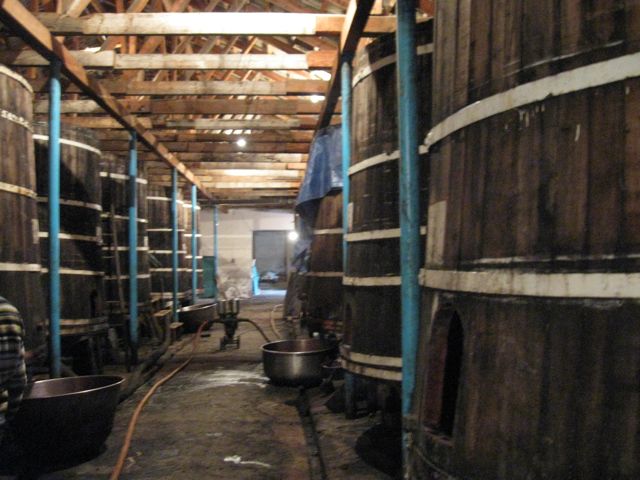
This lady was heating the tops to stick to the bottles and getting ready for them to be sent out.
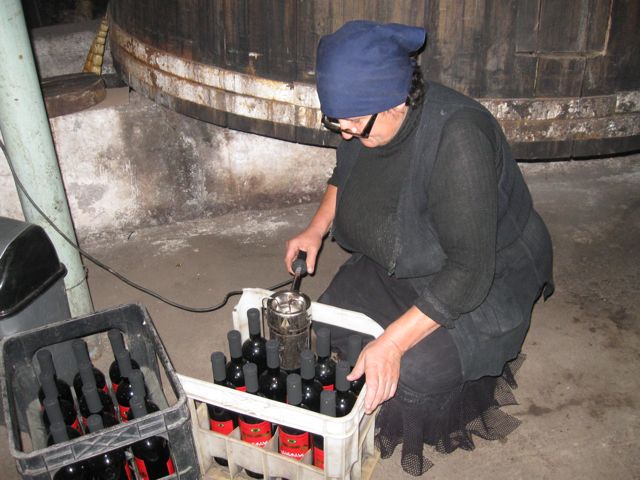
We bought a few bottles to share along the way, and headed back to the guest house. Merab's wife, Nino, who is a primary school teacher had prepared a feast for us, and for me this was a great reminder about what was so great about our trip to Svaneti last year. Eating home cooked food in a family home.
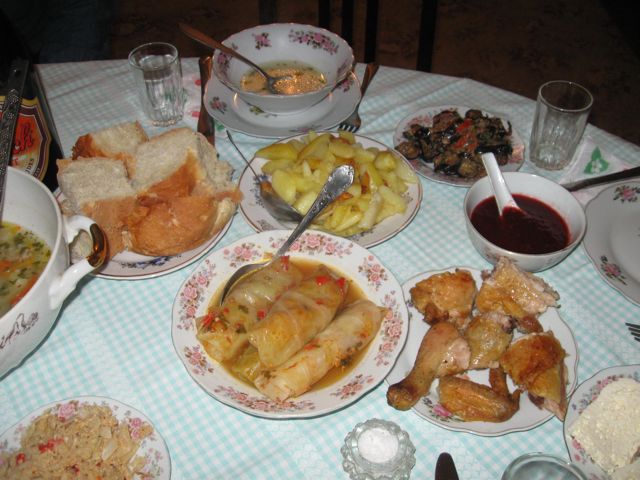
Gaumarjos (Cheers)!

Wednesday 26th October
This morning's breakfast included katchapuri, chicken, rice and pasta.

This was the entrance to the guest house with grapes vines.
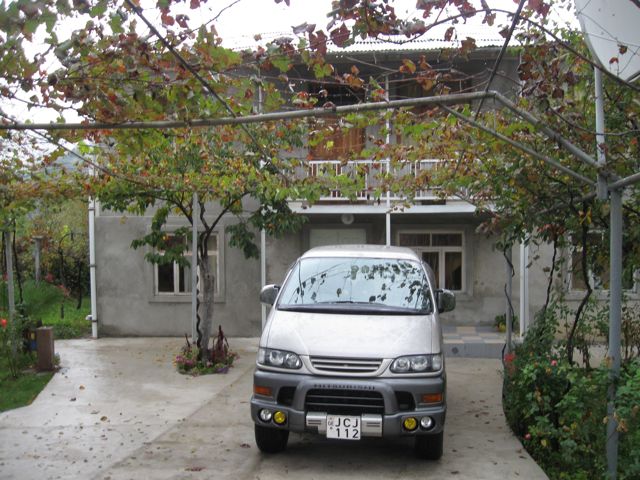
We walked from the house along country lanes to the Rioni river, which we followed for around 5 kms.
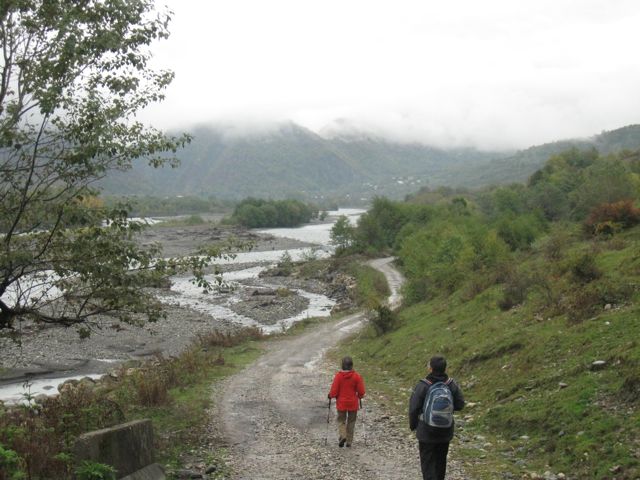
We passed many vineyards along the way as well as free range pigs, cows, hens and geese.

The persimmon trees had wonderful colours, and hay was being stored in the old barns.
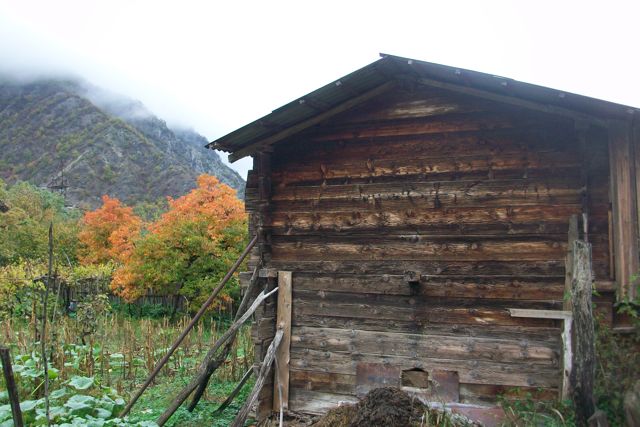
The houses are bounded by metal fencing and decorative gates.

We met interesting characters along the way, including David who was taking fertiliser to his fields. He was a mine of information about the local area which was based around Khimshi village.
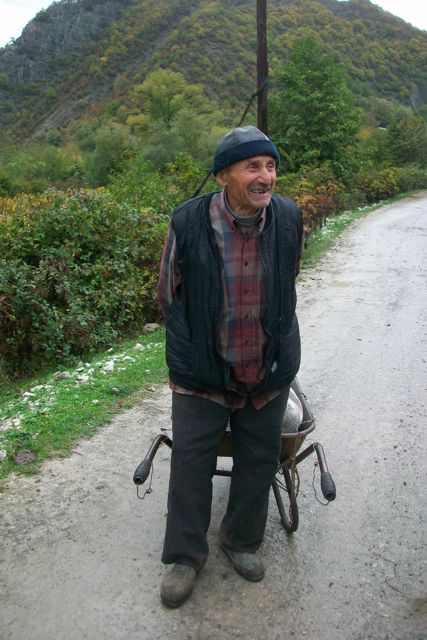
The odd bridge across the river was photogenic - this was just a foot bridge.

Our walking destination was the 18th century Barakoni Church of the Virgin. I arrived ahead of the others and had a good look around, welcomed by puppies and the priest who gave me three candles to light in front of the icons.

We left here and headed to our guest house in Oni. This is in Upper Racha, getting closer to the Russian border. It was definitely colder in this small town. We found our guest house run by Makhvala Berishvili.


She had a feast prepared already for lunch, but in her kitchen were home-made churchkhela, which are a mixture of grape juice, walnuts and flour - a meal in one for shepherds, but a very pleasant dessert also.
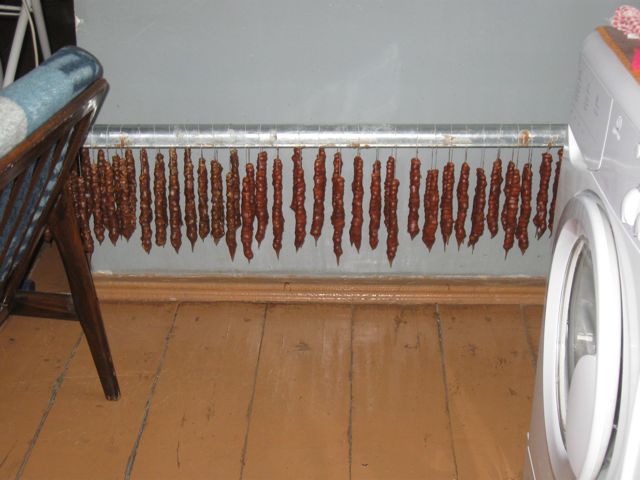
In the afternoon we first went to the very simple but fascinating Oni museum, housed in a very rundown Russian building. There was not room to display all the artefacts, but the very keen curator showed us into the store! Here were piled wonderful household items, including carved chests and chairs. The latter we had seen in Svaneti - they are three-legged and were only to be used by the head of the household.

I loved this sculpture - there were two famous stonemason brothers from Oni. They carved many sculptures in Tbilisi. When one of them died, the other one made this for his tombstone.
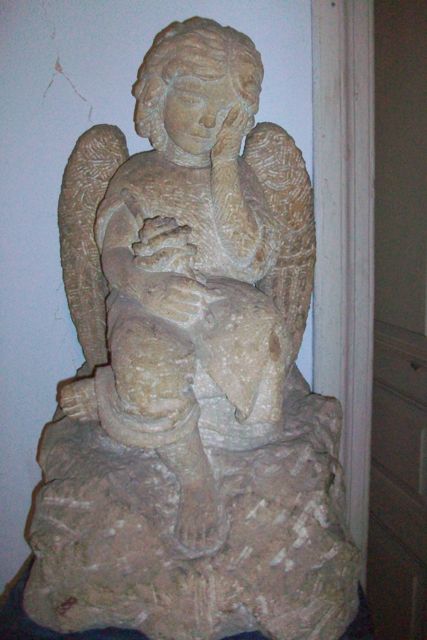
We headed on very rough roads into the autumn hills in search of an old lady they told us about in the museum who sang and danced! A bit of a Georgian wild goose chase, but on the way we met this lovely lady who told us the way.
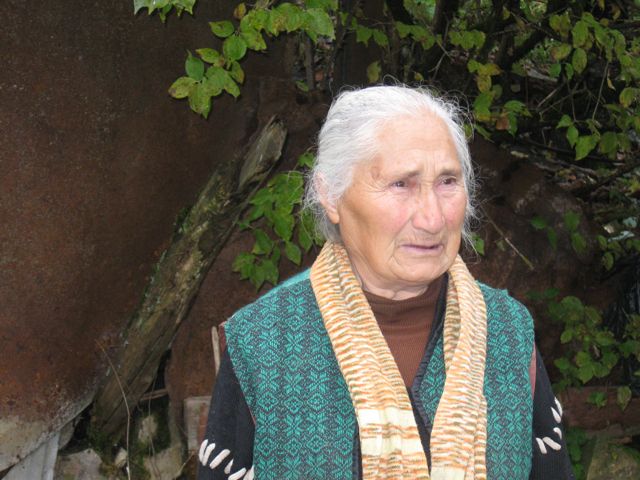
The views were gorgeous even in the haze, but the lady had gone from the mountains to spend the winter in Oni with her son!
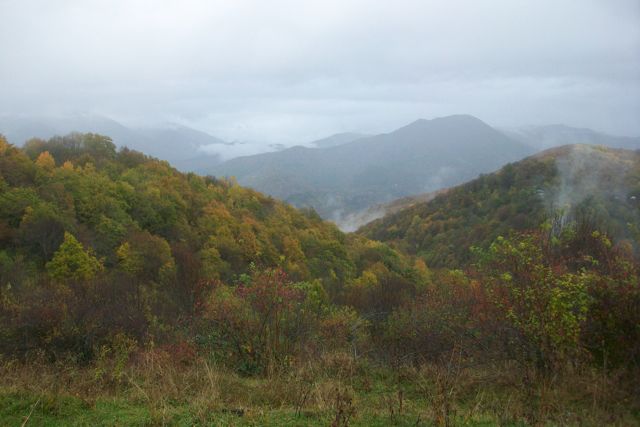
In fact we discovered that many people from the villages of Upper Racha went down the mountains for the winter, and many even to Tbilisi. Quite a number of the houses were packed up for the winter.

Our last stop was at the synagogue in Oni. There had been a large Jewish population of 3000 up until the 70's, but now there are only 25, and no Rabbi based here. It was locked, but we hoped to return later.
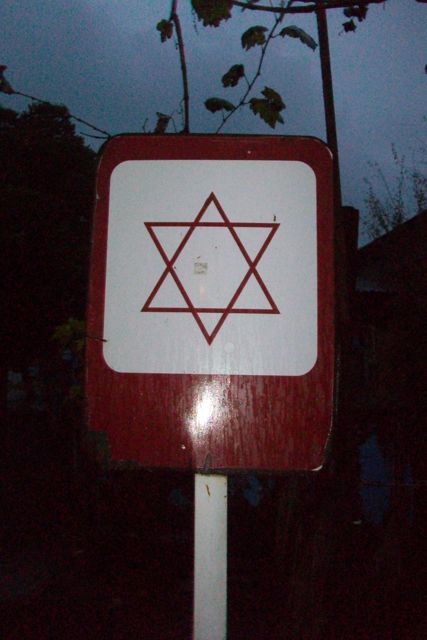
There was no-one with a key available, so we just looked around the outside.
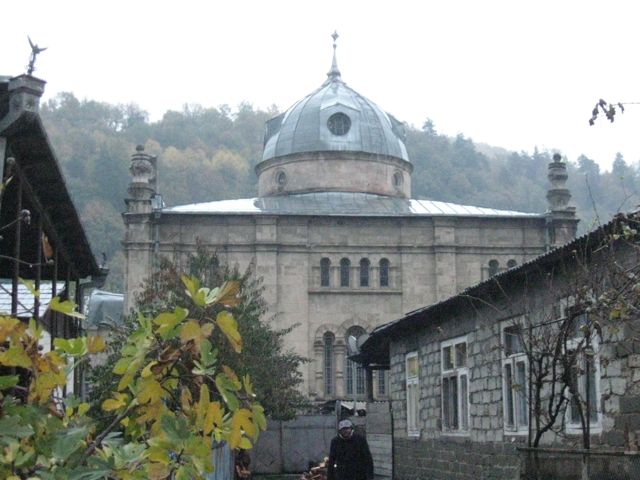
We had a wonderful evening of camaraderie with Makhvala, her niece, Nona and an American student, Abby who is on a Project Georgia scheme teaching English in the local school for a year and living with Makhvala. We all sat around the kitchen for a long time. Makhvala is a great character with many stories to tell, translated by Marika. 10pm was soap opera time on the television so silence had to reign. I was able to catch up with the blog! Makhvala and Nona slept in the kitchen (good idea in the warmth!)
Thursday 27th October
Breakfast in Racha always includes the home-made vodka (chacha)!

Our vehicle parked outside the guest house ready for a day in the mountains.
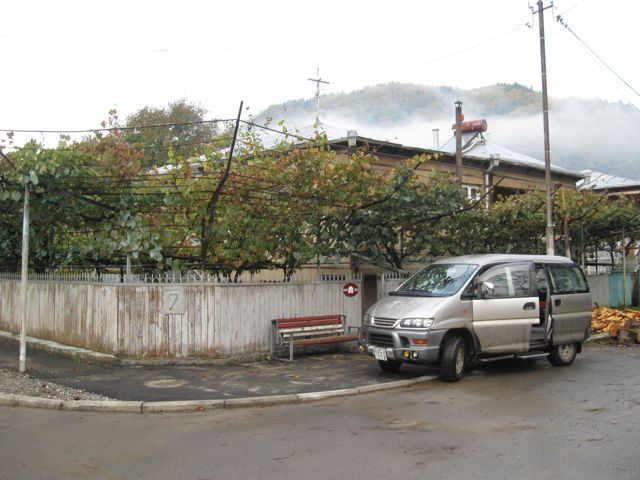
We set off up the Rioni river towards the snow-capped mountains of the great Caucasus, and indeed the border with Russia.
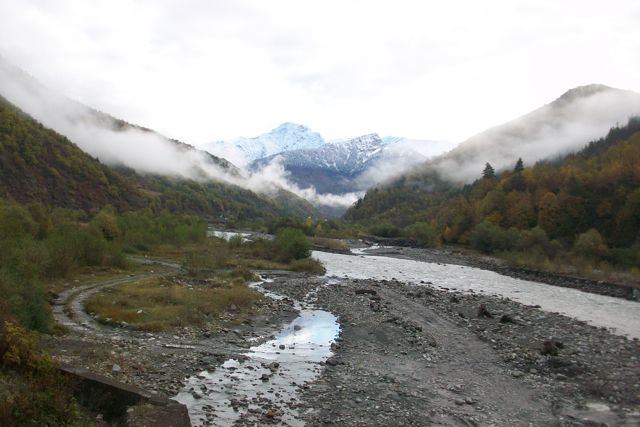
The roads quickly deteriorated into poor conditions, but still the odd vehicle is seen heading for the high mountain villages. The area is famous for its mineral springs, and during the Soviet era there were several health resorts, now really run down. The springs are still active, and Makhvala had given us bottles to fill from different springs! We first went to Shovi, at the base of the Mamisoni mountain range, and just a beautiful peaceful place for walking.
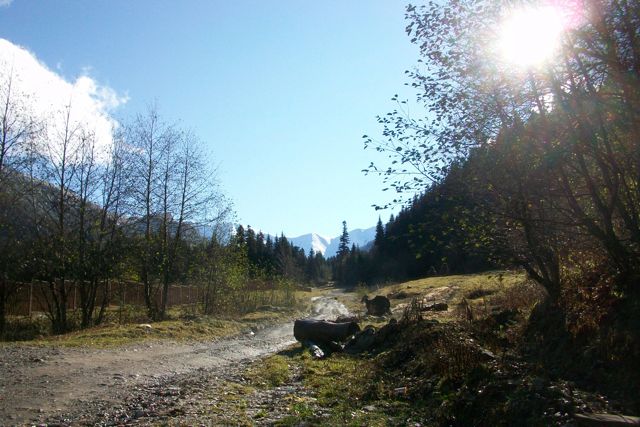
We each explored higher up the valley, and I was reminded of alpine meadows with chalets, or this could be a datcha as we imagined in scenes from Dr Zhivago.

There must have been a snow fall last night as the pine and spruce were coverd in fresh snow.
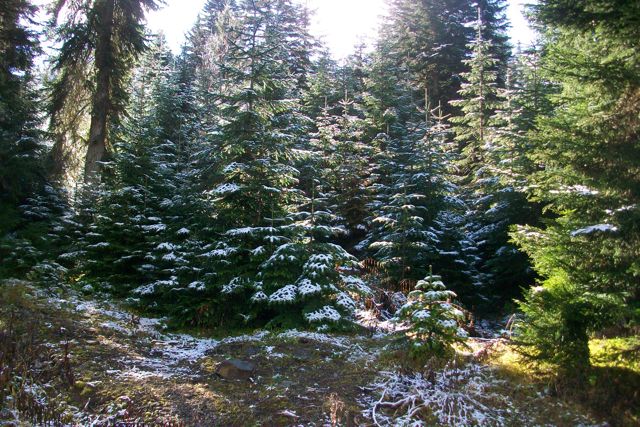
After a couple of hours we headed up another branch of the river to Chiora, which is located at 1360m. This is the last but one village before Svaneti.

We drove up and down the village to find Tamriko Rekhviashvili and her sister, who were preparing lunch for us in their family house.
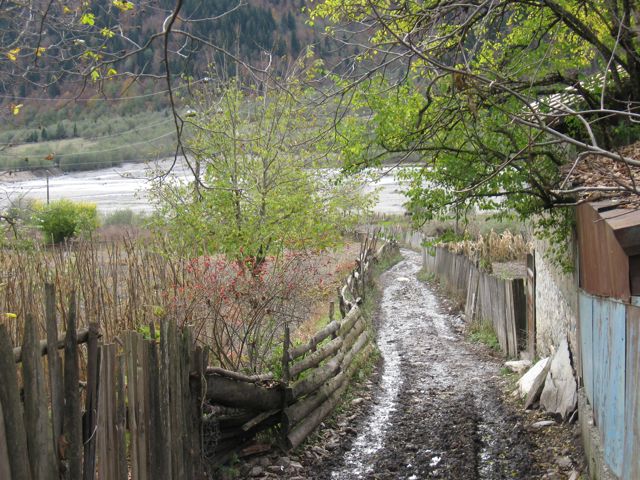
We all sat in the small kitchen watching the lunch being prepared. This is the lobiani, a real speciality of Racha - it is beans stuffed in a bread dough.
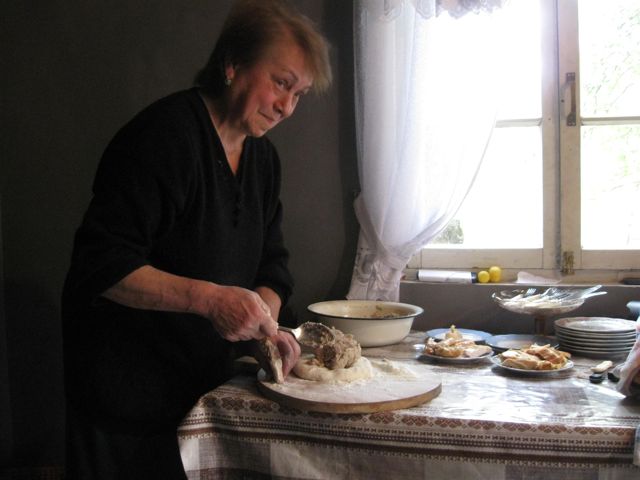
This was then baked in a simple wood burning stove.

These were piled up and then cut into pizza like slices - quite delicious.

They were also making khatchapuri with much more of a scone type mix filled with cheese - on the tray also a fatty pork dish and chicken.
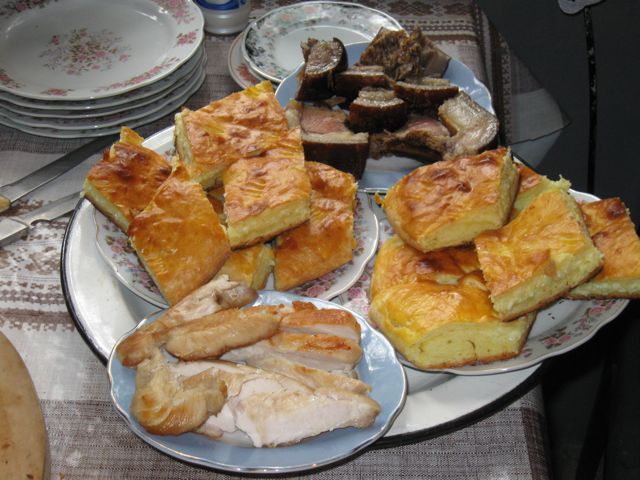
We ate in a bedroom that doubles as a living/dining room area, and the table was groaning, but also included home-made juice, and of course vodka!

After lunch we certainly needed to walk it off, and guided by one of the sisters we set off first up to the church, and then round the old village.

The population is much reduced in winter, in fact the family we ate with were off on Sunday to Tbilisi for the winter. Around seven families only stay up here to brave the snow and cold. In the distance you can see the village of Ghebi, the highest village before Svaneti.

Beth and I loved looking at the old houses and observing the tradional way of life.

In the centre of the village is the mineral spring where all the action takes place and people gather for the mineral waters. Pigs and cattle are free-range here along with the chickens.

Before leaving we met another neighbour, and sat chatting round the stove again. Georgians have a strong sense of connection with the old family villages, though only a few live in them year round now.
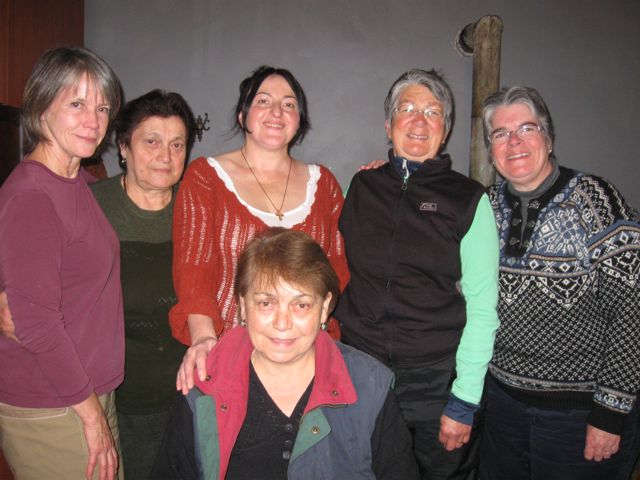
What a wonderful day, fresh air, beautiful scenery and wonderful people.
On the way back to the guest house we had a last abortive attempt to find the old lady who sings, and finality came when we discovered from a neighbour that she had gone to Tbilisi! We had another evening of camaraderie back at the guest house, with Makhvala and Beth even singing some Georgian songs.
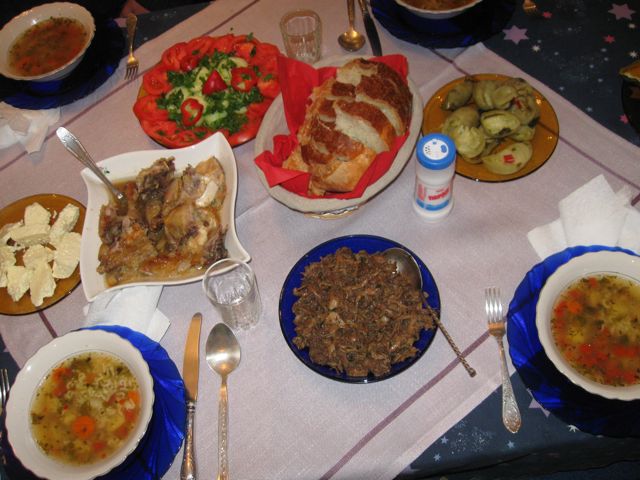
Friday 28th October
Breakfast this morning included freshly made potato cakes - potato inside the dough - very tasty.

We had a very warm relationship with Makhvala - I hope Beth will return to Oni to stay with her again.

Back to the synagogue, where we met Mr. Mikhael, the leader of Oni Jewish community and Mr. Shaliko. They showed us inside the building, and explained that because there are only six men left in the community, they cannot have a service.

Even they are thinking of leaving to join their families in Israel, but they are working hard to ensure that the synagogue is preserved.

On every available shelf there were books in various states of decay.
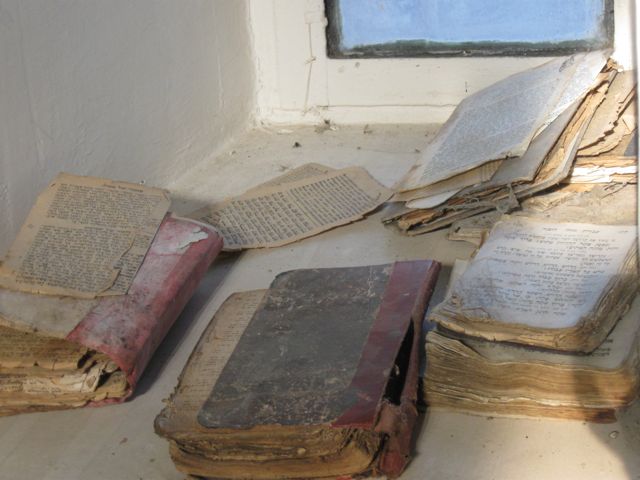
We then headed out of Oni for one last mountain trip, recommended by Makhvala. This was to Mrvalzali - highest village in Racha and the highest church at 2000m.
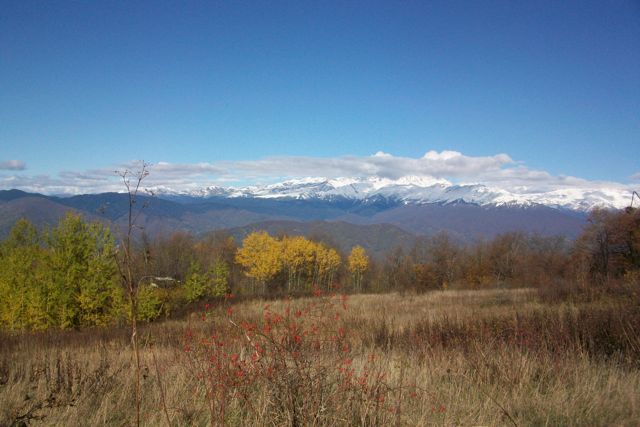
The road was difficult and long, but the rewards were fantastic with such spectacular views all around. We actually walked uphill for the last hour from this point.

The church was always in sight, and we took the shortest routes possible.
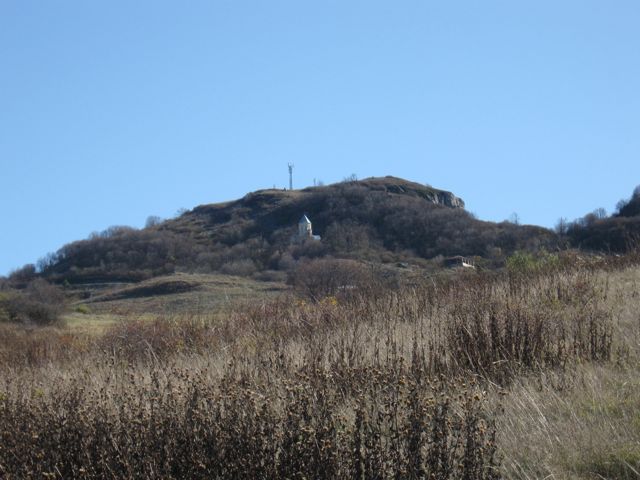
The terrain was not particularly easy as it was a white clay which stuck to the boots, but what a view.

The grazing horses were quite a foreground.

This statue in the village commemorates the fact that during the second world war the Nazis had reached the border crossing of the Caucasus and this village sent 40 horses to defend the post and managed to hold them off.
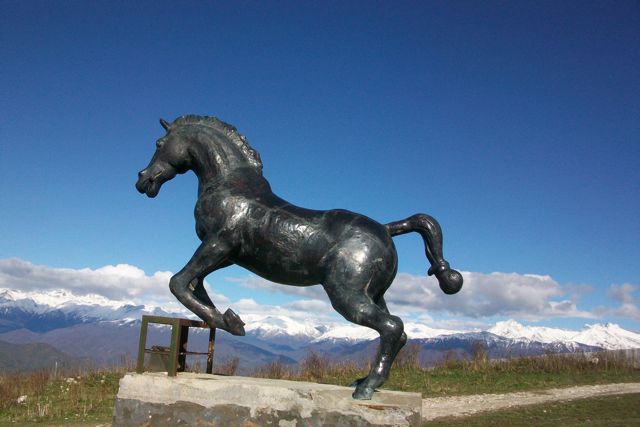
A welcome sight by the time we got there, this church was built in the 11th century on the site of a 5th century basilica. It has been damaged in recent earthquakes, but is so special that it has always been restored.
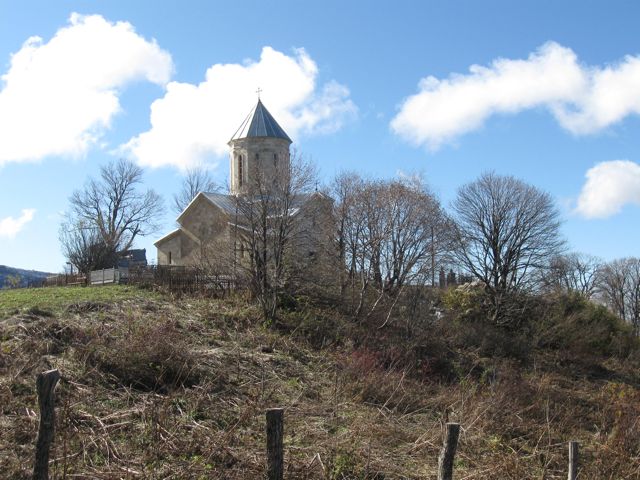
I was ready for a rest and loved sitting on this ancient site with the warmth of the stone.
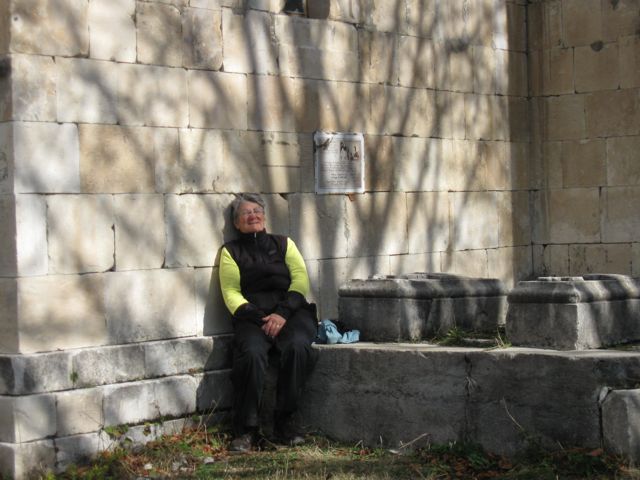
There were many graves around the church - what a place to end your days!
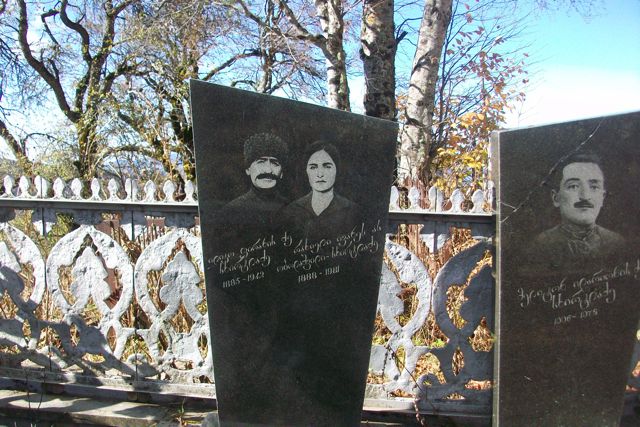

Bartlome, the gate keeper came up from the village and opened the church. He is a descendant of one of the priests, and a former school teacher. What was really touching is that as we were driving back to Tbilisi, he telephoned the driver to see if we had returned safely.

Khaka had made it to the top, so we all piled in on the way down.
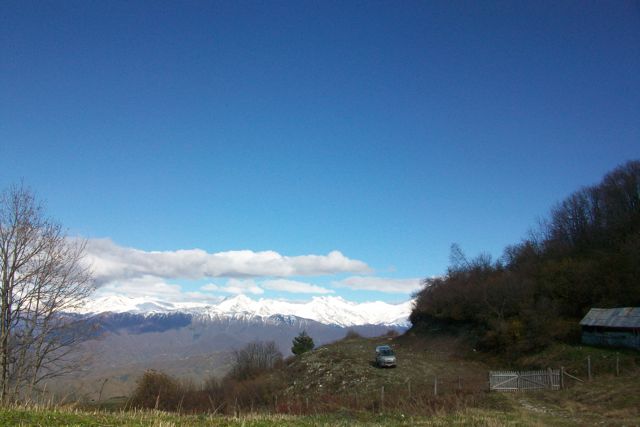
The road was long and difficult, but finally we hit tarmac, and headed south, back to Lower Racha and Ambrolauri, then to Shaori reservoir, with wonderful views of the Caucasus behind.
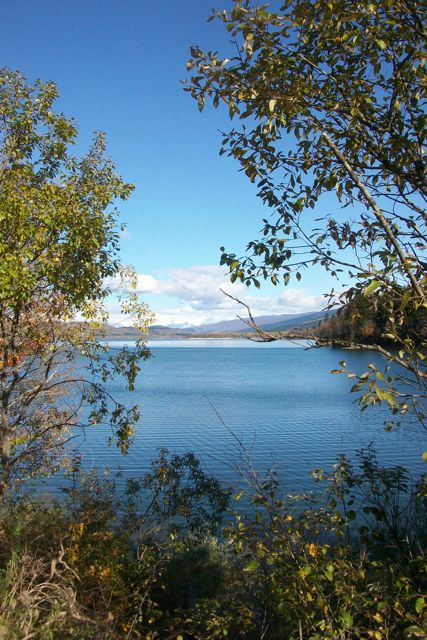
We were blessed with perfect weather for our last glimpses of the mountains.

We crossed back to Imereti province over the Nakerala Pass and descended to the plains and Tkibuli Reservoir, where we stopped for an Imeretian meal.

We ate in this small hut by the lake.
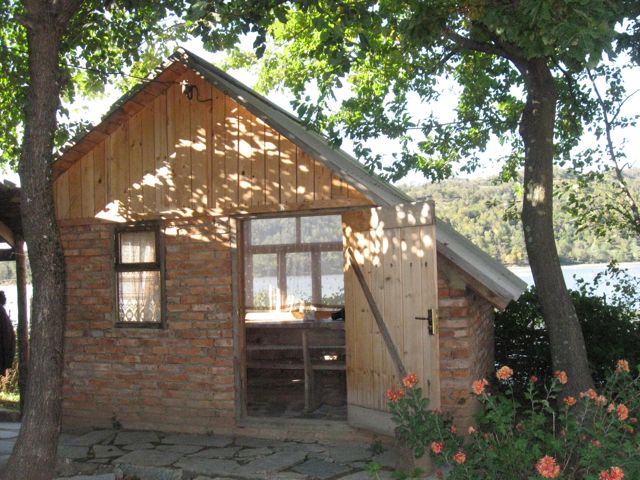
Among the dishes was a delicious pork kebab. As it was our final supra, there were several toasts to our guide and driver with the mulberry vodka brought by Marika!!
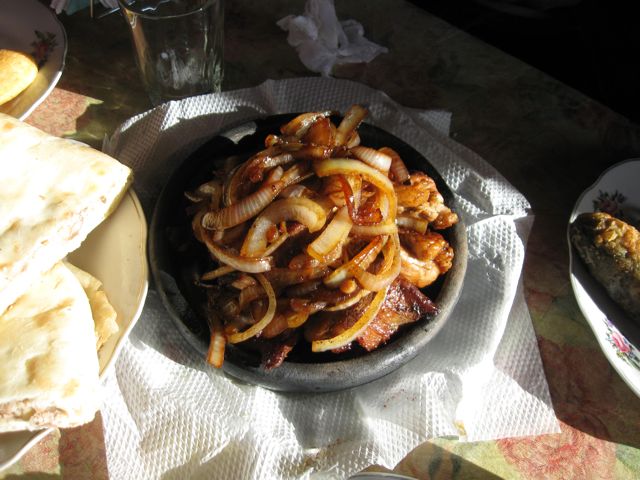
Happy and relaxed after another wonderful Georgian experience. I wonder why people take us for sisters!!
